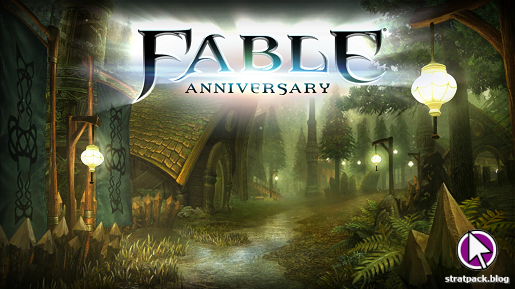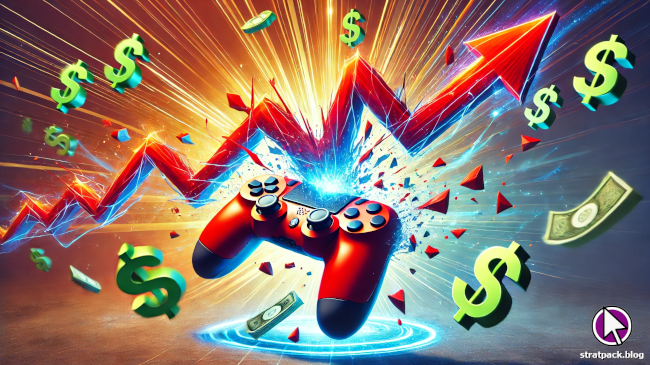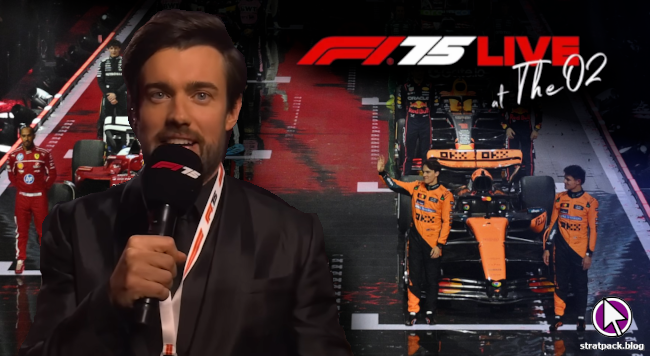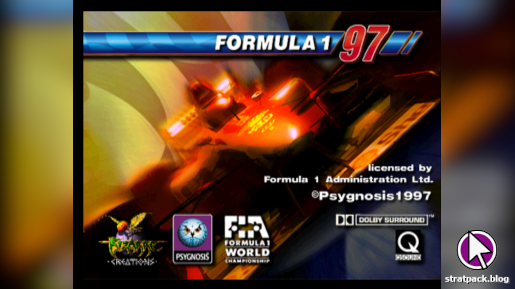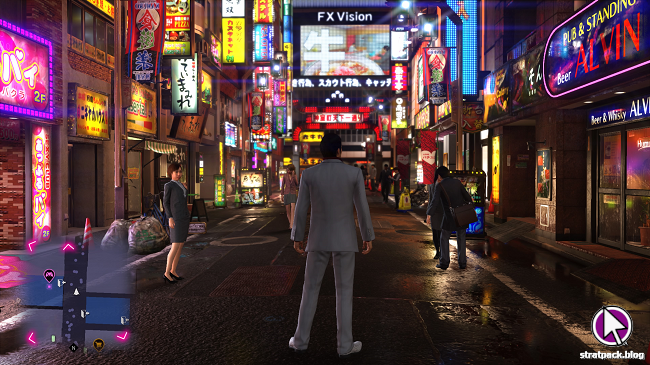
Pro Evolution Soccer 5 (PS2) Master League retrospective
Pro Evolution Soccer 5 has always been an all-time favourite of mine, but it is only now, 15 years after its initial release, that I have found the inspiration to do it justice in words. Of course, there are many reviews out there from 2005 that cover its gameplay, features, and so on, but in this post I have attempted to capture what made it so perfectly balanced and special to many fans. I hope that at the very least this will stir up some nostalgia that inspire others to dig out their copies for a match or two.
Like everyone else, I didn’t have a normal Christmas holiday this year. In my efforts to stave off boredom in the gap between Christmas and the new year, I installed an emulator and grabbed a copy of Pro Evolution Soccer 5 to play. I wasted a huge number of hours playing this game as a teenager, and wanted to see how it held up 15 years and three console generations later. To my surprise, I once again became addicted, and played Master League matches on a daily basis for the rest of the break.
There is some nostalgia involved here, of course – both for the game and the 2005/06 football season – but there are so many things that should have driven me away: the graphics are rough round the edges, the game mechanics are unrefined, and the emulator stutters and occasionally refuses to let me run right until I reconnect my controller. With all these inconveniences, what kept me playing? And why didn’t I fire up my PlayStation 4 or PC and play one of the football games from 2020 instead?
I believe the answer says a lot about design, both in football games and video games in general. I’d always considered PES 5, or more generally the period between Pro Evolution Soccer 4 and Pro Evolution Soccer 6 on PlayStation 2 and Xbox, to be a high tide mark for football games. But even with this in mind when playing more modern games, I could never really pinpoint why. Returning to PES 5 in 2020 with fresh eyes has given me the perspective I needed to put this X factor into words.
Part I: The Master League
The reasons for PES 5’s superiority lie both on and off the pitch. I’ll begin with the latter, which I believe is a masterstroke that is key to the game’s overall addictiveness. The Master League is Konami’s answer to FIFA’s Career Mode – a multi-season campaign that puts the player in charge of a club with financial responsibilities and the freedom to make transfers. However, there are some important differences that lean away from realism and integrate systems more often seen in other video game genres.
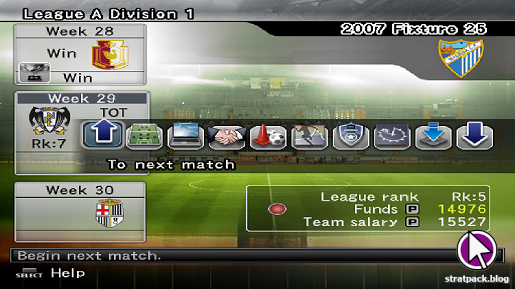
A sense of ownership
The first important difference is that the Master League’s focus is on the club, not the manager’s career. The player can either select or create a team at the beginning of the Master League, and cannot switch to another team at any point. If they choose the latter option, they choose the team’s name, design kits (which integrate with the game world better than similar features in other games due to the range of design options and general lack of licences), and select other attributes like a stadium and crowd colours.
The “real” way to play the Master League is to begin with the default squad, rather than the team’s real-life players. This team, which includes fictional players like Castolo, Minanda, Stremer, and Ivarov, is largely useless in terms of ability. They take touches metres ahead of themselves, hit shots wildly off-target unless directly facing the goal at walking pace, and are outmuscled by even the smallest opponents. This means there is a natural siege mentality for the first couple of seasons, and scraping a point feels like a victory. Unlike FIFA, where selecting Chelsea will mean Champions League matches in your first year in charge, it is not even possible to reach continental competition in the Master League until at least the third season, and even that is unlikely given the players initially at your disposal. This adds to the sense of progression as the player – and by extension their club – earns their place in the footballing world.
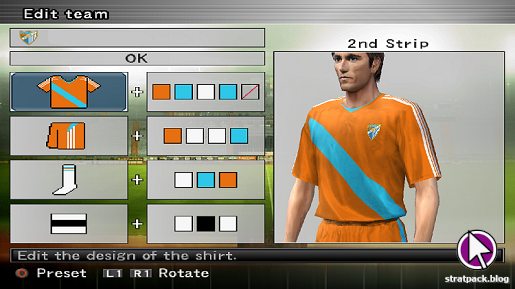
All of this means the player has a far greater sense of ownership than they do in other games’ career modes, where they can take over a successful team of competent players assembled by a real-world manager. This is your club, and as the seasons progress and you slowly bring in talent during the transfer windows, each player in the squad reflects a decision you have made. It’s less realistic, but makes for a far more engaging game – something that will become a recurring theme through this post.
A football RPG
This culminates in a mode structured more like a football role-playing game (RPG) than a sports game. The squad is akin the player’s party, the matches are battles, and the time between is spent managing resources and organising the party in a way that increases the success rate, including keeping track of players’ development and signing new personnel where required. To help them on their way, PES 5 tracks and makes available quite a bit more data than even the most recent football games.
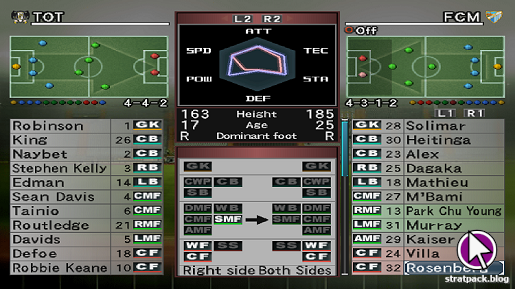
An important aspect of this is that transfers are straightforward, and are far more about affordability than negotiation, which is rarely done well in games. In this respect, the player’s focus is always on their points balance (more on that later) and earning enough to upgrade. They aren’t forced to sit through lengthy office cut scenes, playing a guessing game with an inconsistent AI to agree on a price, and being unable to sign the best players even in the cash-rich end game because of their value to their current clubs.
Scouting players to sign is also more rewarding than in modern FIFA or PES. Players in both current games have an Overall rating, which often reduces comparison to a single statistic and makes choosing between two players, whether for a transfer or a starting position, a one-dimensional affair. PES 5 does not have this statistic, and the player must instead scan each player’s full attributes to gain an impression of their ability. Overlapping star diagrams like the one pictured above allow the player to directly compare six attributes when switching players, sometimes forcing an informed decision – for example, do I choose a full-back who is pacey and attacking, or powerful and defensive? It also helps that the full list of attributes is smaller than in modern games, making it easier to review them in full.
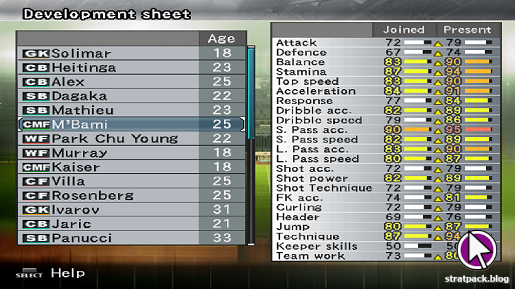
The exaggerated speed and visibility with which these attributes improve also adds to the RPG-like sense of narrative and progression. After each match, the player is taken to a screen where progression points for each attribute stack up for the players that took to the pitch, and it’s hugely satisfying to see your signings’ attributes increase. It’s difficult to compare them exactly, but I believe the progression in PES 5 is also quicker than in games like the modern FIFA series, where a player will join with an Overall rating in the 50s and take a decade to reach full potential. Once again, this is a compromise on realism for the sake of gameplay, increasing the investment that the player has in their squad and club.
Extreme focus
However, the most important part of the Master League, and I believe has been lost in every current career mode, is the fact that it keeps the player extremely focused on a simple task: survival and development. There is no fan sentiment to monitor, no board waiting to sack you, and no possibility of a move to another club. It’s you and your created team against the world, and if they fail, you may be forced to start another game (something that once happened to me, when I foolishly signed Steven Pienaar and saved myself into a corner, ensuring bankruptcy). The risk level is comparable to that of classic arcade games.
Points are the currency in PES 5, and the only number that matters is your bank account balance. You earn points by getting results: 1,000 for a win and 500 for a draw, with bonus points for each goal scored. Your players are paid an annual salary, and if you don’t have enough points to cover the wage bill at the end of the season, it’s game over. Any leftover funds can be used to sign new players, leading to something of a gamble on a mental risk-reward calculation when signing players during the mid-season transfer window – will the added talent be enough to secure the results necessary to pay the wages at the end of the season? Or will your ambition be the cause of your downfall?
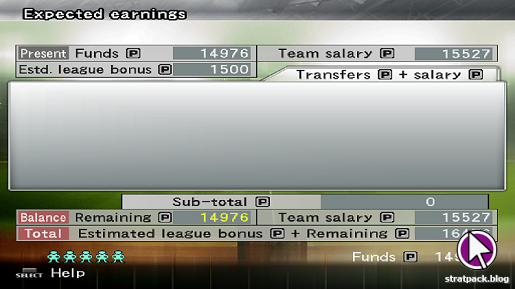
The focus on points and the wage bill adds real tension to the Master League, which is something that isn’t recreated in career modes with separate wage budgets. The stakes of each individual match are raised – especially towards the end of a subpar season – and while the board won’t be on your back for being knocked out of the cup, the number of matches and therefore your chance of winning points is reduced. This can lead to an intense scramble to scrape results in the last few fixtures.
The points system also has the added effect of tying Master League difficulty directly to match difficulty. A greater challenge on the pitch means a lower chance of amassing points and signing star players. As a result, the focus is always on the football and never on dialogue trees, objectives, or working out how to please unseen and unpredictable parties that could cut your tenure short. This makes sense in the big picture, because no PES or FIFA game will ever be Football Manager, so they shouldn’t try to be. Perhaps the Master League economy is a byproduct of development limitations, but accidental or not, it is a beautifully concise system that could be discussed alongside some of history’s best gameplay loops.
Part II: Core gameplay
But what of the gameplay on the pitch, where the player spends most of their time? I remember marvelling at the realism of PES 5 back in 2005, but in retrospect it is nothing of the sort. Quick passes fly about effortlessly, players’ movements follow robotic paths, and pinball-like deflections between bodies produce some truly comedic spells of play. These issues may have been the due to the hardware of the time – there’s only so much Konami could do with physics and AI on a PlayStation 2, after all - but these compromises in the representation of real-life football also serve to make the game more fun.
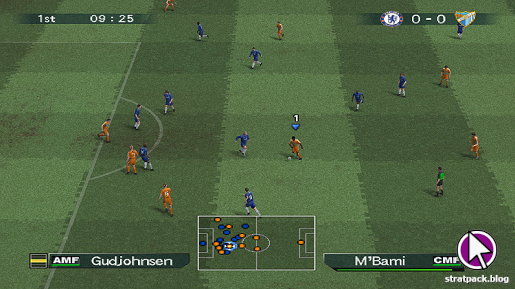
The beautiful game
No football game before PES 5 – and arguably no game since – flows as fantastically as Konami’s masterpiece. Its gameplay mechanics are designed for fast, end-to-end action, with passes pinging between players with pinpoint accuracy, but ball control that is heavy enough that any attempt to break into a packed penalty area carries a real risk of losing possession without creating an opportunity. This means shooting from distance is just as viable an option, and it is possible to score some real 30-yard screamers with the more talented players of the time like Frank Lampard and Steven Gerrard.
The game’s attacking balance is unmatched – you’re just as likely to score or miss with a long shot, a run through the middle, or a cross into the box – and this variety is catalysed by the aforementioned element of randomness. All those different shot types, deflections, mistakes, and rebounds add an organic unpredictability that means that even after hundreds of hours of play, players still see new situations emerge. This stops attacking and defending, even against the AI, from falling into the predictable patterns seen in many football games (like some FIFA editions’ six-yard box square-pass-and-shoot goals).
AI and momentum
It’s also worth taking a moment to discuss the AI, which you’ll be seeing a lot of if you choose to play the Master League mode. Simply put, PES 5’s AI is a bigger challenge than any modern football game’s equivalent. Three seasons into my new campaign, I was just about winning consistently on four stars, and that still left me with the five-star mode (and the six-star mode, unlockable via the PES Shop) to take on.
I believe a lack of predictability is again what makes the AI work so well – it seems to have a random element, and also encounters all the scraps and deflections that you do, which stops the player from learning that opponents will always pass in a certain direction or pattern. Perhaps this generation of football games was also slightly easier to develop AI for, in that the game engine itself was simpler, and there were fewer mechanics for the AI to have to interpret and choose between.
PES 5 matches also benefit from being left to run their course naturally. In 2021, football game forums are rife with complaints about alleged “momentum” mechanics – the idea that the game “wants” a certain result for entertainment value, and makes a losing team more likely to score a last-minute equaliser or pits a dominant player’s championship challengers against a team fighting relegation who seem to gain superhuman powers if the player has won too many matches recently. While I remember reading some initial murmurings about momentum at the time, PES 5 seems to largely let the game flow, free from artficial drama. The bulk of the “momentum” you’ll find here is in the commentary (particularly from Trevor Brooking, who seems obsessed with the word, especially following goals).
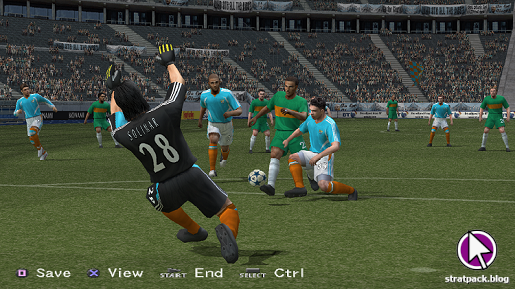
Party on the pitch
Earlier, I discussed the Master League mode’s RPG-like elements, and these are also present as you take to the pitch, with the game adjusting noticeably to players’ attributes and engineering situations for them to take effect. Starting a player with less fatigue and better form is often more beneficial than starting a jaded superstar, and some abilities like the famous lofted through ball are essentially locked off until you have skilled enough players. These limitations initially led me to believe the game was much more basic than I remembered when I first picked it up, but as I acquired more talented players and began to see the effects on the pitch, I began to realise that this was just another facet of its complexity.
In a similar way, a game of PES 5 includes several subtle, and sometimes slightly frustrating, gameplay features that digress from real football in the name of playability. Low-skill players take huge touches when controlling even the simplest pass, for example, and players almost always stumble when tackled, making it impossible to instantly win the ball back. This also seems to be the reason for one of the most often criticised occurrences, when the ball will occasionally pass through a player’s leg. This was criticised and branded unrealistic at the time – particularly by fans of the rival FIFA series – but it’s really Konami rolling the D20 once more, and the attacker’s ability and luck totalling more than the defender’s (or vice versa). It can be visually jarring, but it’s the kind of nuanced feature that keeps the game flowing.
Straightforward set pieces
Whenever a new iteration of a football game is at the drawing board, the developers need to make a decision on set pieces, and in the 2000s we saw a huge variety of systems employed. In my opinion, PES 5 strikes the balance better than any, again bringing player attributes to the forefront. Rather than a complicated system of giant arrows, ball contact diagrams, and stop-the-slider mini games, Konami gave us three means of influencing free kicks: the initial angle, a power bar, and the application of curl with the D-pad. The result leaves the player feeling far more connected to the action – free kicks are fast, direct, and satisfying when they hit the top corner, and (as is the case with all good game design) when the player fails, they always feel as though they might do better next time with a slight change of technique.
Penalties benefit from being even more straightforward. Both the player and the goalkeeper select one of nine directions – that’s it. No power bar, no stuttering run-ups or star jumps on the line, and no fancy chips down the centre. What happens next is a combination of luck and player attributes – even if the goalkeeper dives the right way, they might not keep the shot out if their skills don’t match the striker’s, and the taker always stands a chance of hitting the post or missing entirely. The way the outcome is calculated feels fair, balanced, and in sync with the rest of the match engine.
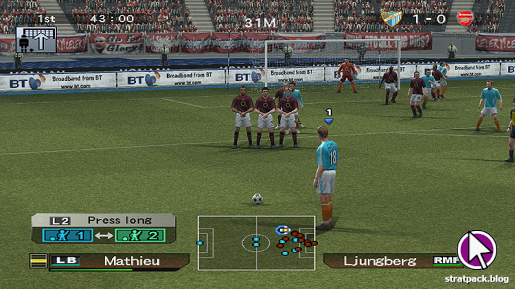
An imperfect masterpiece
All of this isn’t to say that PES 5’s interpretation of football is perfect. Referees in particular could have used some refinement. After noticing them constantly blowing for soft fouls, sometimes nowhere near the ball, I initially held back on tackling, fearing that I’d gather bookings just as easily. But despite being massively strict on minor infringements, they seem to have no sense of whether a foul was committed by the last man. A deliberate but minor foul on a player through on goal will usually yield no card – the AI does it to me, I do it to the AI, and it essentially becomes another fair gameplay tactic.
The advantage rule is also massively inconsistent, and is something modern football games undoubtedly do better. The main issue here is that the period that the referee plays advantage for tends to be very short. If an opposing player fouls my attacker and the ball happens to fall to his strike partner, the advantage icon disappears almost as soon as he controls it, meaning no free kick is awarded even if he is being tightly marked and is immediately dispossessed. There are also many times where the referee stops play when playing on would have given the attacking team a chance on goal. The advantage rule was a feature introduced in PES 3, but even two editions later it was in desperate need of improvement.
Finally, despite the flowing gameplay and organic deflections, the players themselves aren’t always the quickest to react to unexpected passages of play. Generally this isn’t an issue, but it can be frustrating to see a deflected clearance apparently fall into your star forward’s path, only for him to refuse to approach the ball, letting a more distant defender get there first and clean up the mess.
Part III: The future of gaming
So, what does this analysis of a 15-year-old football game tell us about video games more broadly? I think the key message is that a compromise between realism and gameplay, which used to be forced upon developers by the PlayStation 2’s limited hardware, is essential to creating a more playable game. The conversation around sports games always seems to be around which title more closely resembles the real game, but perhaps the focus would be better placed on which is more fun instead.
While this post has examined PES 5, the same is true of games in other genres. Looking at another Konami series, Metal Gear Solid evolved in a similar way. Metal Gear Solid 2 and 3 were arguably the series’ peak, when gameplay was constrained to small areas that presented controlled, isolated challenges, and a large amount of effort was spent adding colour, story, and character. Fast forward to Metal Gear Solid 5 and emphasis is squarely on open-world gameplay, with few cut scenes and little memorable dialogue. Anybody from the mid-2000s would be stunned at the gameplay features, but the game loses its focus, both thematically and in terms of the gameplay – there are any number of situations the developers did not account for where the player can engineer situations that confuse the AI, either exposing bugs (and breaking immersion) or lowering the difficulty. It is a game in desperate need of focus, both in terms of the player experience and where development time was allocated.
Gameplay over realism
A niche more commonly explored by mid-level and indie developers is the game that has fairly simple mechanics (or at least features that have been relatively stable for years) and modern graphics. This section of the gaming market is wide-ranging, but I would point to examples like Football Manager, the rebooted Hitman series, and the modern Wolfenstein and Doom games. These games follow almost the same core gameplay formula that similar titles did 15 years ago, but the developers have used the extra power at their disposal to make them prettier, refine mechanics, and improve their AI, rather than adding additional complexity unnecessarily or targeting hyperrealism at the expense of player enjoyment.
In the football genre in particular, I suspect there are many disenfranchised players out there who like me would jump at the chance to play a game similar to the classic PES titles, but with minor improvements (for example, updated graphics, better referees, and more consistent player control) rather than additional features that increase realism but make the game more of a chore to play (slower, heavier gameplay; player complaints and conversations, press conferences and negotiation cut scenes).
PES has improved somewhat during the PS4/Xbox One generation, but it definitely isn’t as fast or addictive as it was previously, and the Master League has been diluted massively in pursuit of FIFA’s Career Mode. With the focus on cash-generating online services like FIFA Ultimate Team and MyClub, gameplay has remained relatively consistent for a while now, but perhaps there’s a small developer out there that could make take a chance on a simpler, more arcadey title that resembles a refined classic PES.
Until then, I’m hooked once more on the classic Pro Evolution Soccer formula, and at least for the foreseeable future, PES 5 is going to remain my football game of choice.








